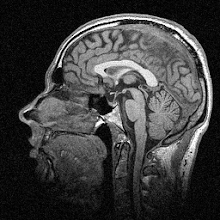In today’s paper, the authors investigated how generalization works when you are learning two things at the same time, in different areas of space. The observation method they chose was amplitude gains - reaching to a target in a particular direction and modifying the feedback to increase or reduce the gain. So, for example, for a gain of 1.5 participants would have to reach 1.5 times further than normal to hit the target, and for a gain of 0.5 they would have to reach half as far as normal.
The researchers trained their participants on two gains (1.5 and 0.8) simultaneously for two different targets, and then tested how the reaches generalized to some untrained targets:
Trained and untrained targets
The thick circles in the figure show the trained targets and the thin circles show the untrained targets. How the participants reached to the untrained targets after training on the trained targets can be used as a measure of how well they generalized their movements.
One obvious problem with generalization when learning two things at once is that the two generalization patterns might conflict, and prevent you learning one of the gains at all. But the results weren’t that simple. The participants quite happily learnt both gains, and their generalization varied smoothly based on distance from the training directions. The result is illustrated by this rather complex-looking graph:
Generalization based on target direction
Don’t be put off though. Just look at the thick black trace, which is the average of all the other black traces. Along the x-axis of the graph is direction in degrees, and along the y-axis is the observed gain, i.e. how far participants reached to the target at that particular position. You can see that at the trained targets at 60˚ (gain 0.8) and 210˚ (gain 1.5) the observed gain is close to the training gain, and as I said above, it varies smoothly between the two as you look at the different untrained targets.
So it’s possible to learn two gains at once, and the amount you generalize varies across the workspace in a smooth way. But scientists aren’t scientists if they’re satisfied with a simple answer. They wanted to know: why’s that? What’s the best model that explains the data, and that is consistent with what we know about the brain? The authors proposed five possible models, but the one they found fit the data best was a relative spatial weighting model.
The idea behind this model is fairly simple. We can quite easily find a generalization pattern from a single gain, and this model combines the two single-gain patterns based on the relative distance between the two training directions.
What does this mean? Well: it gives credence to the idea that the motor system adapts to differing visuomotor gains using something called a ‘mixture-of-experts’ system. Each ‘expert’ module learns one of the gains, and then combines them based on an easily-assessed property of the workspace (in this case, the angular distance between training targets). This modular idea of how the brain works has grown in popularity in the last decade, and this paper is the latest to demonstrate that there appear to be distinct systems that learn to be extremely good at one thing and are then combined and weighted together to deal with complex tasks.
That’s it for this week! Today’s post was under 700 words, which beats the first (~950) and the second (~1150!). I’m going to try to keep them shorter rather than longer, but I could do with some feedback on my writing. Comments very welcome.
---
Pearson, T., Krakauer, J., & Mazzoni, P. (2010). Learning Not to Generalize: Modular Adaptation of Visuomotor Gain Journal of Neurophysiology, 103 (6), 2938-2952 DOI: 10.1152/jn.01089.2009
Images copyright © 2010 The American Physiological Society



No comments:
Post a Comment